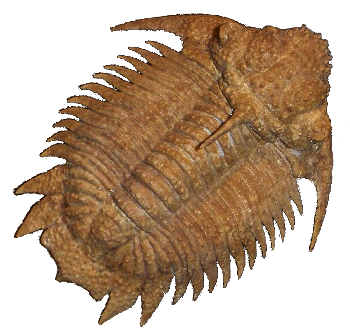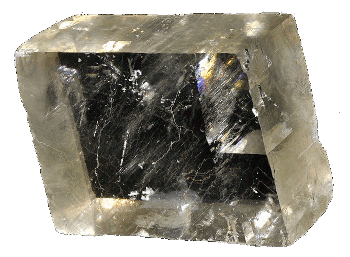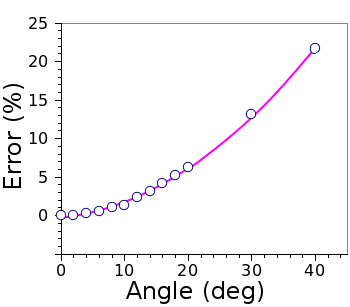The Trilobite Eye
May 3, 2013
The
eye is such a complex structure that many people have trouble with the idea that
Nature could have created eyes through
evolution. That's not such a problem when you consider that the fully-formed
mammalian eyes we see today were not created
ex novo; rather, they are the end point in a long chain of smaller steps.
As an
experimentalist, I see a parallel between the
evolutionary development of the eye and the differences between my string and
sealing wax (nowadays,
duct tape and
five-minute epoxy)
prototypes and the final
commercial products based on them.
Charles Darwin highlighted the eye as something seemingly difficult to explain by evolution. However, he then reasoned that "...numerous gradations from a simple and imperfect eye to one complex and perfect can be shown to exist, each grade being useful to its possessor..." would do the trick.[1] I'm reminded of the ancient
proverb, as listed by
Erasmus in his
Adages, "In the land of the blind, the one-eyed man is king."[2]
Animal eyes have
lenses formed from the
protein,
crystallin, an apt name for such a
transparent material. The now
extinct trilobites (
Animalia,
Arthropoda,
Trilobitomorpha,
Trilobita), which encompassed ten
orders of
species, are a remarkable exception. Trilobite eyes were made from the
inorganic material,
calcite. A recent
arXiv posting by Vernon L. Williams discusses the
optical properties of calcite and their affect on
lens performance.[3]

Trilobite fossil of the genus Hoplolichoides.
Ordovician trilobite fossils are numerous in the Ordovician clay of quarries around Saint Petersburg, Russia, where this specimen was recovered.
(Photo by Ghedoghedo, via Wikimedia Commons.)
Radioactive trilobites make an appearance in the original
Godzilla film (1954,
Ishiro Honda, Director).[4] Trilobites were a remarkably successful species, flourishing in the
oceans for 270 million years from 520-250 million years ago.
Calcium is abundant in ocean water, so calcite crystal, which is
chemically calcium carbonate, was a ready choice as a lens material, as it was for the trilobite
exoskeleton.

A calcite crystal of the Iceland Spar variety.
Hexagonal crystals often have such a rhomboid habit.
(Photograph by Parent Géry, via Wikimedia Commons.)
Trilobite eyes were
compound eyes constructed much like
insect eyes, as an array of closely-packed hexagonal
facets. For trilobites, the material for these facets was optically-clear calcite, an
hexagonal crystal, the "c-axis" of which was oriented with the axis of incoming
light rays. Although calcite is optically transparent, it has one other optical property. It's
birefringent.
Non-polarized light entering a birefringent crystal is split into two beams, one of which (the "ordinary" beam) follows the
usual refraction laws, with the other ("extraordinary" beam) going off at a different
angle. These beams are actually a split of the
polarization of the entry beam, a phenomenon much beloved by early
optical physicists, who used this effect of calcite in
Nicol and
Glan-Thompson prisms to polarize light.

Seeing Double
Photograph showing how the double refraction of calcite will split an image in two.
A calcite crystal was placed over some text.
(Via Wikimedia Commons.)
This splitting of the beams arises from the different
refractive indices of calcite for the two polarizations. For 600
nm light, roughly in the middle of the
visible range, calcite has an ordinary index
no of 1.486, and an extraordinary index
ne of 1.660. These different indices cause the beam paths to diverge when the incident beam is not along the
optical axis (c-axis).
This divergence isn't a problem at small angles, but it causes a fuzzy image for calcite lenses when there's a wide
field of view. For trilobites, this meant that they had good forward vision, but they had poor
peripheral vision, probably mitigated by the compound nature of the lens (see graph). If your object is just to eat things in front of you and avoid large
predators moving towards you from any direction, this probably wasn't too much of a problem.

Focal depth error as a function of angle, measured from the optical axis, for a typical calcite lens.
The source data for this plot are from ref. 3.
(Graph of data from Table I of ref. 3, rendered using Gnumeric.)[3)]
Transparent calcite is just one form for calcite crystals, and there are many
opaque forms. One interesting chemical property of calcite is its
retrograde solubility. Nearly every
water-soluble crystal
dissolves faster in hot water. Calcite is less soluble in water as the
temperature increases; and, no, trilobites didn't have their eyes dissolve in their ocean environment, since it was a high
pH solution (
basic).
References:
- Charles Darwin, "On The Origin Of Species.
Or The Preservation Of Favoured Races In The Struggle For Life," Sixth Edition, 1859, via Project Gutenberg.
- Erasmus quotes the proverb as, "In regione caecorum, rex est luscus" (Adages III, iv). I prefer the simpler, "Inter caecos, luscus rex."
- Vernon L.Williams, "Evolution and the Calcite Eye Lens," arXiv Preprint Server, April 3, 2013.
- Godzilla, Ishiro Honda, Director, 1954, on the Internet Movie Database.
Permanent Link to this article
Linked Keywords: Eye; Nature; evolution; mammal; mammalian; ex novo; experimentalist; evolution of the eye; evolutionary development of the eye; sealing wax; duct tape; five-minute epoxy; prototype; commercial product; Charles Darwin; proverb; Erasmus; Adagia; Adages; Animal; lens; protein; crystallin; transparent; extinct; trilobite; Animalia; Arthropoda; Trilobitomorpha; Trilobita; order; species; inorganic compound; inorganic material; calcite; arXiv; optics; optical; fossil; genus; Ordovician; quarry; Saint Petersburg, Russia; Wikimedia Commons; radioactive decay; radioactive; Godzilla film; Ishiro Honda; ocean; calcium; chemistry; chemical; calcium carbonate; exoskeleton; Iceland Spar; hexagonal crystal system; rhomboid; crystal habit; compound eye; arthropod eye; insect eye; facet; light ray; birefringence; birefringent; non-polarized light; Snell's law; refraction law; angle; polarization; optical physics; optical physicist; Nicol prism; Glan-Thompson prism; double refraction; refractive index; nanometer; nm; visible light; optical axis; field of view; peripheral vision; predation; predator; Gnumeric; opacity; opaque; retrograde solubility; water; dissolution; temperature; pH; basic; On The Origin of Species.